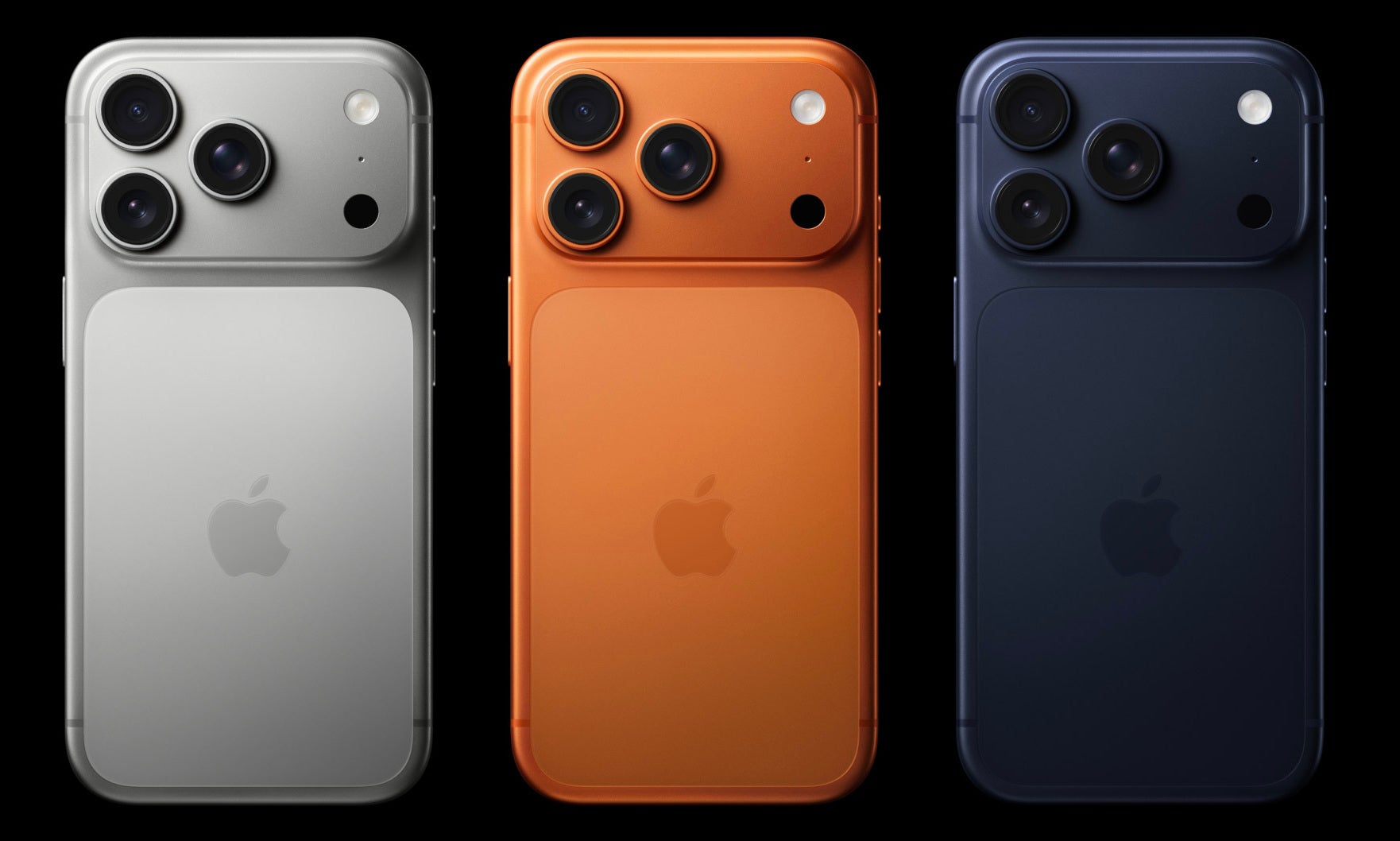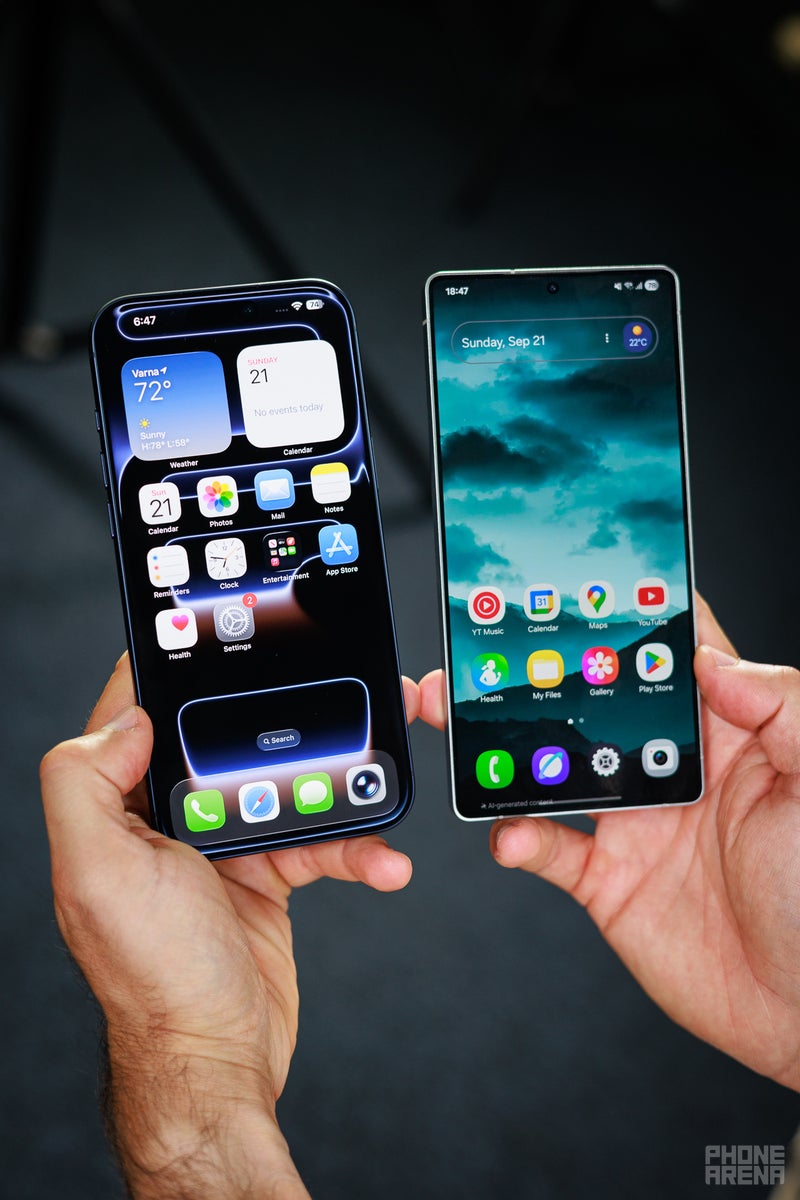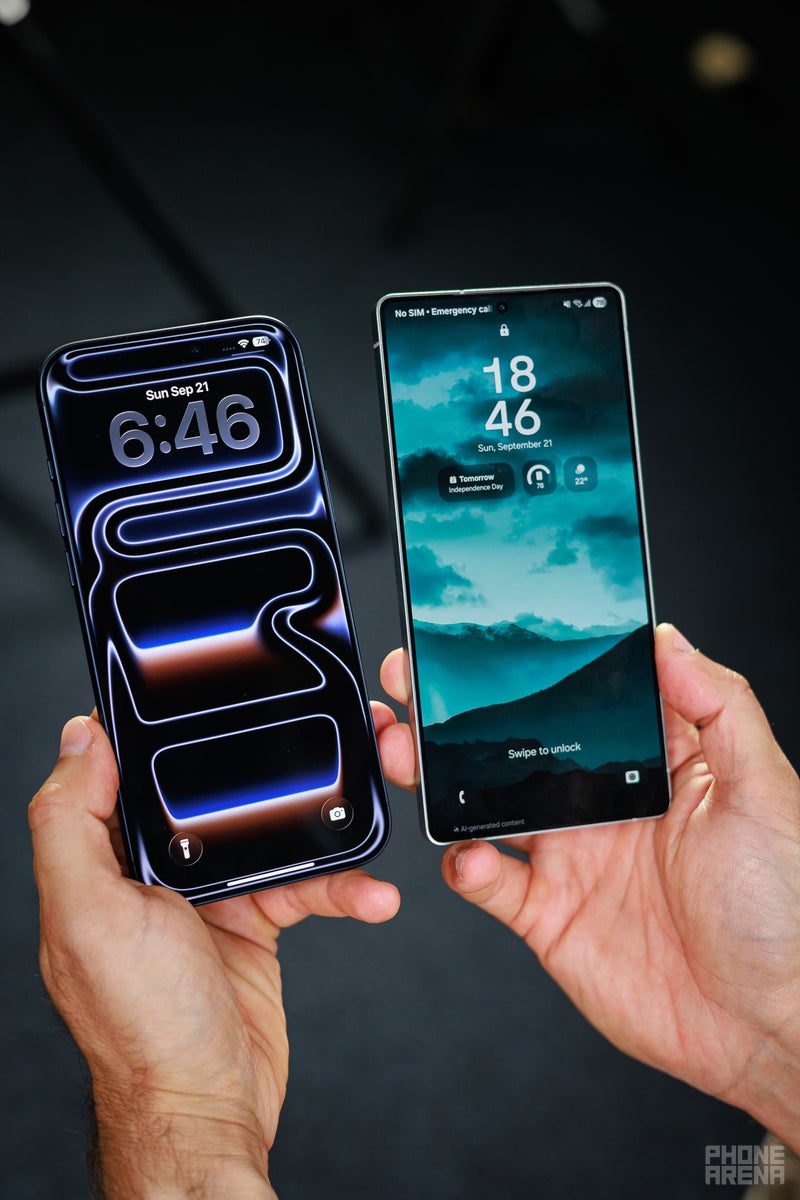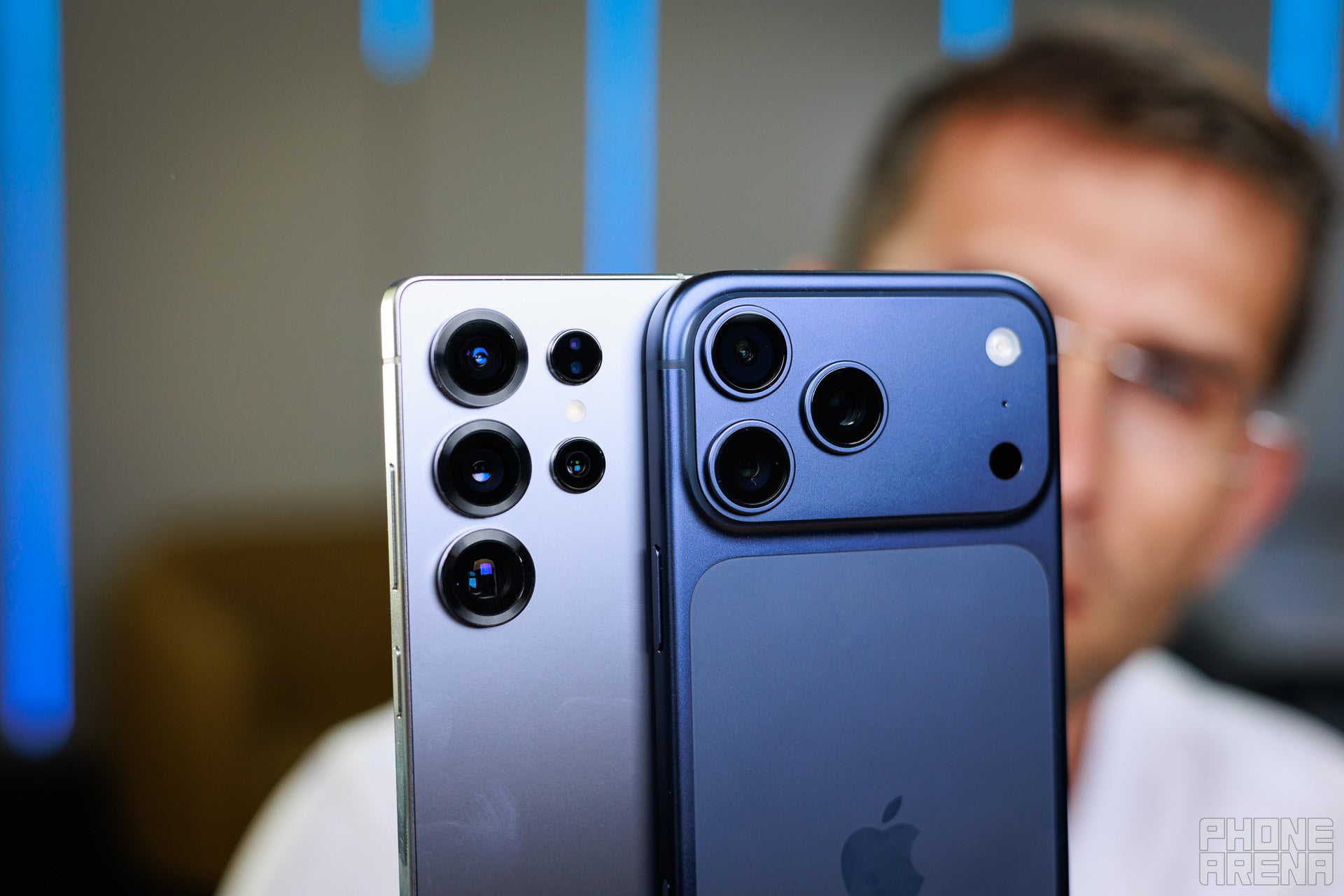It’s the natural competitor is Samsung’s Galaxy S25 Ultra, which has been out for about 8 months now. Samsung’s camp offers not one but two zoom cameras, enhanced digital zoom with AI, a lot of Galaxy AI features and Gemini on board for a full-rounded package of smart. Plus, Samsung rocks a Qualcomm Snapdragon 8 Elite tuned for Galaxy, squeezing some more GHz out of an already powerful chip.
So, does the iPhone 17 Pro Max have enough upgrades and pizzazz to cut down on Samsung’s momentum? Or is the Galaxy S25 Ultra the one flagship that will get loyal Apple fans to switch?
To find out the answer, we will be putting the two flagships through our gauntlet of battery, camera, performance, and display tests, plus a pinch of anecdotal experience. Let’s go!
The iPhone 17 Pro Max was, surprisingly, redesigned. It’s not wildly different but it does have a rather peculiar new camera bar on the bach. A camera plateau, Apple calls it. It’s also now back to being made with aluminum. As a reminder, premium iPhones have been made with stainless steel since the iPhone X, then titanium for a couple of years — the 15 Pro and 16 Pro. And now we are back to aluminum. Presumably because it’s better at dissipating the heat from the A19 Pro processor, and is lighter.
The Galaxy S25 Ultra still features a titanium-coated frame. It’d be interesting to see if Samsung drops it now that Apple has. And its cameras are still the “floating” style rings in the top left of the phone’s back, which does result in some uneven wobble. On the upside — they do look kind of sick.
The matte glass back on the iPhone is now the Ceramic Shield. 4x more durable against cracks, compared to whatever glass Apple was using before that. It’s also a much smaller subsection of the phone’s back — there’s a lot more aluminum back there now, with the matte glass being a small “pane” in the lover 2/3rds of the iPhone 17 Pro and Pro Max. That is where the MagSafe charging coil and its magnets live, and it needs to be not metal, so that the wireless charging can happen in the first place.
The Galaxy S25 Ultra has an all-glass back with a matte finish — it’s a Gorilla Glass Victus 2, which is well-known for its durability.
On feel in the hand, the iPhone does have a whole new camera bar to get used to. However, you can quickly learn to rest it against your index finger, and its smooth sailing from then on. Otherwise, the beveled frame feels nice and soft against the palm. The Galaxy S25 Ultra itself had a bit of a redesign this year, now also delivering flat frames and slightly rounded corners, but its frame is not beveled. Some users like the sharp edges — they provide the feeling of better grip. Others have the harsher feel of it.
Both phones also offer a 6.9-inch screen panel. The iPhone is slightly thicker, and a bit heavier:
The iPhone 17 Pro Max does have more buttons on its exterior — there’s the power button, the volume keys, then the muti-functional Camera Control button and programmable Action button. That’s a lot from a company who, just a few years ago, was venturing to remove all buttons from its phones. Samsung takes it easy here with just power, volume up, and volume down.
The new Pro iPhones come in a surprisingly limited selection of colors — Silver, Deep Blue, and Cosmic Orange. On one hand, I am happy that we at least have one quirky and fun color for the Pro line iPhones. On the other, it’s kind of shocking that the black or Space Gray are entirely gone right now.


The Galaxy S25 Ultra comes in Titanium Gray, Titanium Black, Titanium Whitesilver, and Titanium Silverblue. Further variants are exclusive to the Samsung.com store — Titanium Jadegreen, Titanium Jetblack, and Titanium Pinkgold.


Both of these phones can hit excellent brightness numbers. Yes, the Samsung is a bit lower, but its anti-reflective coating being better gives it a leg up in real life use scenarios. But what’s even cooler is that both display panels hit sub-1 nit measurements for minimum brightness. That’ll make both excellent bedsude buddies. Plus, there’s the blue-light filter and automatic whitepoint adjustment on both, so they are catered to being easy on the eyes.
Performance and Software
Apple silicon vs the Samsung-Qualcomm partnership


Apple’s A-series chips have been at the top of the game for years. However, over the past couple of generations, silicon-slinger Qualcomm really caught up. Especially since it partnered with Samsung for design and manufacturing — that might be a coincidence, we really don’t know how much hand in the process Samsung had. After all, Sammy’s own Exynos chips are not amazing.
In any case, the Qualcomm Snapdragon 8 Elite Made for Galaxy inside the Galaxy S25 Ultra is an excellent performer. But Apple’s A17 Pro is an entirely new beast, and it now has the vapor cooling chamber to back it up for sustained performance. Results?
| iPhone model | iPhone 17 Pro Max | Galaxy S25 Ultra |
|---|---|---|
| Chip | Apple A19 Pro | Qualcomm Snapdragon 8 Elite |
| Manufacturing process | 3 nm | 3 nm |
| Memory | 12 GB | 12 GB |
CPU Performance Benchmarks:
Wow, what a showdown! Both of them give respectable performance in the single-core test, but yes, the A19 Pro does pull ahead by quite a bit. However, for multi-core, they are neck-in-neck. If you’ve been making your decision based on benchmark numbers, this is going to be a tough nut to crack!
The Galaxy S25 Ultra does start off a bit higher than the iPhone 17 Pro Max. However it throttles down lower, and faster. To be clear — the 3DMark test is specifically designed to force phones to throttle. It’s a question of how long it will take and how much they will slow down. The iPhones over the past couple of years took half a cycle to go way down. However, the upgraded vapor chamber seems to be doing wonders this year — the iPhone 17 Pro Max throttles slowly over 3 benchmar cycles and then settles at a “lowest” score that is still quite high!
For storage, the iPhone 17 Pro Max repeats the previous tiers — 256 GB minimum, then 512 GB, 1 TB, and a new 2 TB upgrade. The Galaxy S25 Ultra comes with 256 GB, 512 GB, 1 TB.
The real productivity boosts, though, are in the Phone and Messages apps. Call Screening and Spam Filtering make their iOS debut, and Live Translate now works in real-time during calls — a long-awaited answer to Samsung’s equivalent features. What’s more, Messages adds chat backgrounds, typing indicators, and group polls.
Other tweaks include Smarter Apple Maps routing based on your habits, and a less cluttered Photos app that finally makes albums easier to reach.
Apple’s iPhones typically get 5 years of iOS support, but that might change, as Samsung and Google have really pushed the envelope on update commitments.
Camera
The eternal camera battles


Both of these phones are leaders in the camera field — both Apple and Samsung have been putting a lot of eggs in the camera basket and the result is that we have competing flagships that can take super high-res photos and videos with excellent stabilization and editing tools. Well, some editing tools are better than others.
The iPhone 17 Pro gets a trio of 48 MP Fusion cameras on the back. Fusion is basically a fancy way of saying that Apple uses sensor crop-in magic to get “lossless” zoom levels and kind of simulate various focal lengths. In this spirit, it can go up to 8x and take 12 MP photos at what can be called “optical zoom”. From then on, it’s all digital, now upgraded to a 40x maximum — up from last year’s 25x, but still a far cry from Samsung’s 100x Space Zoom.
Samsung, of course, employs four different cameras to get actual zoom levels. And its longest lens is a 5x telephoto — the jumping off point for that 100x digital. In our benchmark, the Samsung scores a couple of points higher than the iPhone 17 Pro Max — it’s a negligible difference. It basically tells us that these two cameras are of very similar quality, even if they sometimes decide on slightly different exposures or color grading.
Main Camera
A perfect example where the iPhone picture came out warmer and more vivid, while the Samsung photo is a bit more down to earth, colder and more contrasty. Either style can work for you and there’s the added benefit that Apple does have the Photographic Styles that let you fine-tune said colors and vividness (we take our samples in the default Neutral).
Apple did promise better night performance and we can see it here. Surprisingly smooth balance between shadows and highlights, with a lot of detail pulled from both. A few months ago, the Galaxy S25 Ultra looked like it had excellent night photos. Now it looks a tiny step behind, with more jagged edges around the grass and slightly more washed out highlights.
Zoom Quality
At 10x zoom, the Samsung wins with better details and less noise. Surprisingly, colors are about the same from both cameras.
Ultra-wide Camera
The ultra-wide camera of the Galaxy S25 Ultra, for some reason, gave us more saturated and vivid images, with skewed greens and blues. A total opposite of the main camera comparison here.
Selfies
The yellowish hues of the iPhone strike again. But details and dynamics from both are great.
Otherwise, the new selfie camera from Apple is entirely new tech — it now uses a square sensor, and allows you to take selfies however you like — horizontal or vertical.
Video Quality

Above, you can see a video sample comparing the quality of the two phones.
Battery Life and Charging
The power of 5,000
Apple typically doesn’t play the battery capacity games. iPhones historically have had smaller batteries than their contemporary competitors, but have made up for it with excellent software and hardware optimizations.
However, one must get with the times. The Pro Max devices usually house big cells — and the iPhone 17 Pro Max pushed beyond that 5,000 mAh barrier! eSIM-only models (US) come wht 5,088 mAh. With iOS, that means 2-day battery life easily. The rest of the world has to make do with 4,832 mAh, which is still more than last year’s model.
Samsung also doesn’t push the envelope too much. Ever since that Galaxy Note 7 snafu, the manufacturer slowed down its battery efforts significantly and now prefers to play it super-safe, just in case. The Galaxy S25 Ultra has 5,000 mAh and it’s pretty OK. It can last you like a day and a half with regular use, and won’t trigger your low-bat-phobia often.
| iPhone model | iPhone 17 Pro Max | Galaxy S25 Ultra |
|---|---|---|
| Battery size | 4,832-5,088 mAh | 5,000 mAh |
| Wired charging speed | 40W | 45W |
| Wireless charging speed | 25W | 15W |
PhoneArena Battery and Charging Test Results:
We finally get a charging speed upgrade. The iPhone 17 Pro Max can now get up to 50% of charge in just 20 minutes on a 40 W power brick. Hooray!
Specs Comparison
| iPhone 17 Pro Max | Galaxy S25 Ultra |
|---|---|
| Size, weight 163.4 x 78.0 x 8.75 mm 233 g |
Size, weight 162.8 x 77.6 x 8.2 mm 218 g |
| Screen 6.9″ OLED 120Hz ProMotion 3,000 nits peak brightness |
Screen 6.9″ AMOLED 120Hz 2,600 nits peak brightness |
| Processor A19 Pro 3nm |
Processor Snapdragon 8 Elite 3nm |
| Versions: 12GB/256GB 12GB/512GB 12GB/1TB 12GB/1TB LPDDR5 |
Versions: 12GB/256GB 12GB/512GB 12GB/1TB LPDDR5X |
| Cameras: 48MP main 48MP ultra 48MP 4X 18MP front |
Cameras: 200MP main 50MP ultra 10MP 3X zoom 50MP 5X zoom 12MP front |
| Battery: 5,088 mAh (eSIM) 4,832 mAh (international) |
Battery: 5,000 mAh |
| Charging: USB-C 40W wired 25W MagSafe 2.0 |
Charging: USB-C 45W wired 15W Qi2 |
Summary
The iPhone 17 Pro Max is a solid upgrade, especially in terms of hardware. It’s sustained performance is a market leader right now, and Apple is poised to take more and more of that mobile gamer niche. The camera updates may be incremental but they are solid. And pro users will enjoy the new ProRes RAW for video for sure.
Bottom line, if you can find the S25 Ultra at a discount, it’s still an awesome phone. If you go and buy the iPhone 17 Pro Max at full price instead, there’s definitely good reason to do so.
